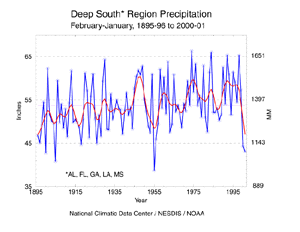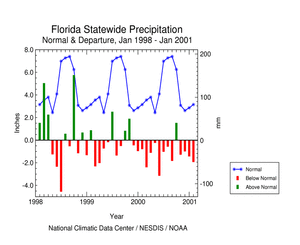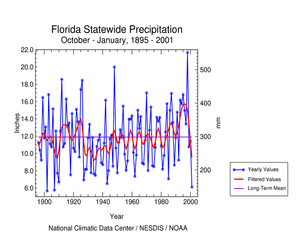Contents Of This Report:

 National Overview
National Overview
| On the national scale, severe drought affected about eleven percent of the contiguous United States as of the end of January 2001, reflecting a slight increase from the overall conditions of last month (see graph below left). At its August peak of 36% coverage, the 2000 drought was as extensive as the major droughts of the last 40 years, but not as large as the "dust bowl" droughts of the 1930's and 1950's (see graph below right).
A large part of the western U.S. experienced the third dry month in a row (click here for the Palmer Z Index map for January, December, and November). While short-term conditions were near normal in much of the southern Plains and Deep South, long-term conditions remained quite dry in this region. Although different parts of the U.S. have experienced unusually wet conditions during the last 12 months, there continues to be little change in the overall national wetness picture. The percentage of the nation severely wet has remained near five percent during this period (see graph below left). |
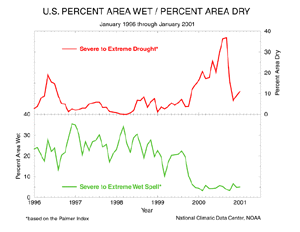 larger image |
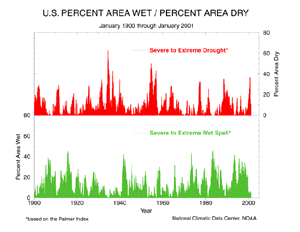 larger image |

 Palmer Drought Indices
Palmer Drought Indices
| The Palmer Z Index shows how monthly moisture conditions depart from normal (short-term drought and wetness). January 2001 was severely dry in the Pacific Northwest and adjoining areas, in the Northeast, and parts of the Mid-Atlantic states. The animated maps to the right show the geographical pattern of the moisture anomalies for the last 12 months. On these maps, the red shading denotes dry conditions while the green shading indicates wet conditions. | 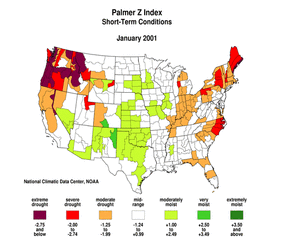 larger animated image |
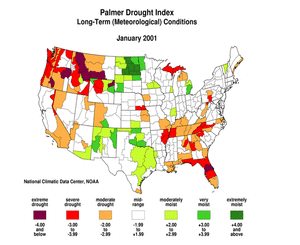 larger animated image |
The Palmer Drought Index maps show long-term (cumulative) meteorological drought and wet conditions. Long-term meteorological drought persisted across parts of the Deep South and southern Appalachians, and long-term persistent dryness intensified across parts of the Pacific Northwest and northern Rockies. The animated maps show how the geographical pattern of the long-term (meteorological) moisture conditions has changed over the last 12 months. On these maps, the red shading denotes drought conditions while the green shading indicates wet conditions. |
| The Palmer Hydrological Drought Index maps show hydrological (long-term cumulative) drought and wet conditions, which more accurately reflect groundwater conditions, reservoir levels, etc. The PHDI indicates that hydrological drought persisted through the end of January across most of the Southeast and parts of the West, central Plains, and northern Great Lakes. The animated maps to the right show the geographical pattern of the long-term (hydrological) moisture anomalies for the last 12 months. On these maps, the red shading denotes dry conditions while the green shading indicates wet conditions. | 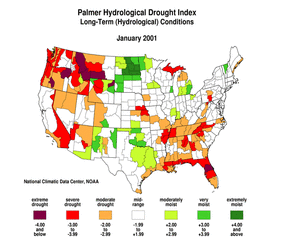 larger animated image |

 Regional Drought Watch:
Regional Drought Watch:
 Standardized Precipitation Index
Standardized Precipitation Index
| The Standardized Precipitation Index (SPI) is another way of measuring drought. The SPI is an index based on the probability of recording a given amount of precipitation, and the probabilities are standardized so that an index of zero indicates the median precipitation amount (half of the historical precipitation amounts are below the median, and half are above the median). The index is negative for drought, and positive for wet conditions. As the dry or wet conditions become more severe, the index becomes more negative or positive. While the Palmer Drought Index is a water balance index that considers water supply (precipitation), demand (evapotranspiration) and loss (runoff), the SPI is a probability index that considers only precipitation.
The seven maps below show the January 2001 spatial patterns of SPI for seven different periods ranging from one month (short-term conditions) to 24 months (long-term conditions). When taken together, they give a combined geographical and temporal picture of the severity of precipitation anomalies. The maps illustrate, for example:
|
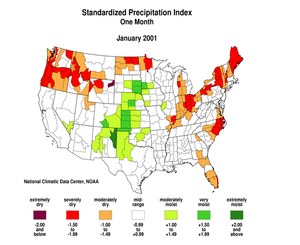 larger image |
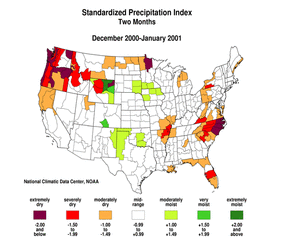 larger image |
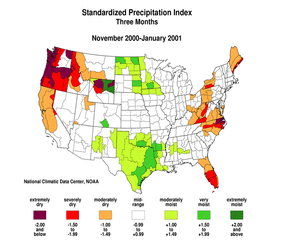 larger image |
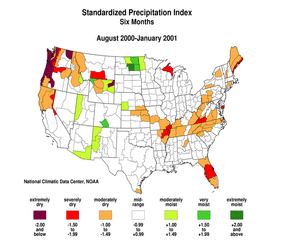 larger image |
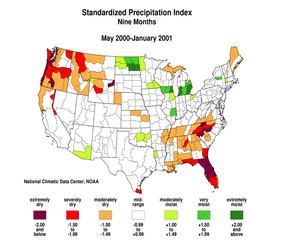 larger image |
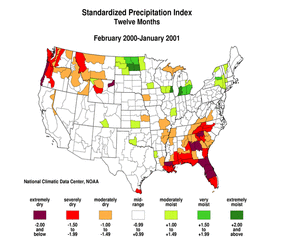 larger image |
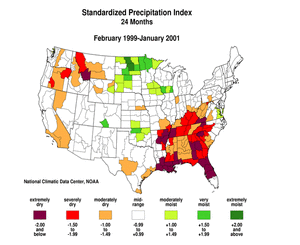 larger image |
 Regional Overview
Regional Overview
| The following table shows the precipitation ranks for the nine standard U.S. regions for January 2001, the three-month period November 2000-January 2001, and the twelve-month period February 2000-January 2001. A rank of 1 is driest and 107 (for January, 106 for the other periods) is wettest.
|
| The map to the right shows the departure from normal of the number of days with measureable precipitation for the three-month period, November 2000-January 2001. The short-term dryness in the Northeast, Central, and western regions, as well as in Florida and Hawaii, shows up on this map as significant below-normal (brown) number of precipitation days. | 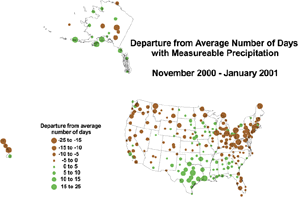 larger image |
 Deep South Drought
Deep South Drought
| Parts of the U.S. Deep South (AL, FL, GA, LA, MS) experienced welcomed rains this month, however precipitation averaged across the region was still below normal (see graph below left). January 2001 ranked as the 38th driest January in the region's aggregate record. Only two of the last 15 months had regionwide precipitation above normal (see graph below left), giving the 12-month period, February 2000-January 2001, a rank of fourth driest such period on record (see graph below right). The Deep South region has suffered from drought for the last two and a half years, resulting in two consecutive back-to-back dry (fourth and fifth driest) February-January "years" (see graph below right). Across the Southeast region, January 2001 ranked as the 15th driest January on record and February 2000-January 2001 ranked as the fourth driest such 12-month period. South Carolina Forestry officials reported that January 2001 had more wildfire activity than any January in the last 15 years.
|
|
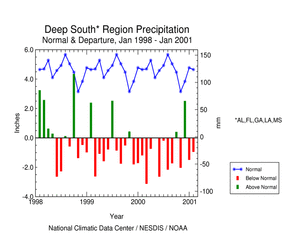 larger image |
| Much of Florida experienced another dry month in January. Only one month out of the last 15 had above-normal precipitation (see graph below), giving the state the driest February-January (see graph below left) and third driest October-January (see graph below right) on record in 2000-2001. Hydrological impacts included reduced streamflow, lake, and groundwater levels, and over 800 wildfires developed in several areas since the first of the year, including one fire in the exposed lake bed of a drastically low Lake Okeechobee. In response to the worst drought conditions since the 1930's, emergency mandatory water-use restrictions continued in many Florida communities. |
|
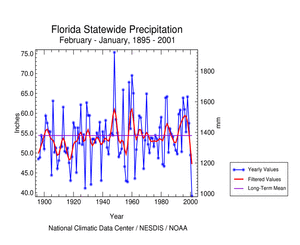 larger image |
 Pacific Northwest Dryness
Pacific Northwest Dryness
| Much of the Pacific Northwest experienced the third dry month in a row in January 2001 (see graph below left). This persistent dryness occurred during the normally wet season and resulted in the fifth driest January, second driest November-January (see graph below right), and fourth driest February-January on record during the 2000-2001 season. Rivers are setting new January records for low flows in some Oregon and Washington valleys, reservoir levels are generally below normal, and mountain snowpack was less than 70% of normal for the end of January in many river basins and near 50% of normal or less in some basins. |
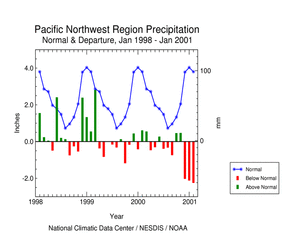 larger image |
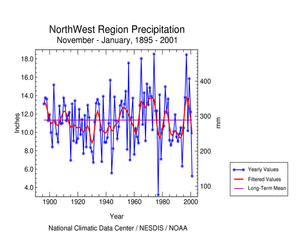 larger image |
 Western Region Dryness
Western Region Dryness
| Near normal precipitation fell across much of the West region during January (see graph below left). However, the dryness during the first two months of this wet season gave the region the ninth driest November-January on record (see graph below right). Streamflow and statewide snowpack were low in California, but water storage in reservoirs was near normal. |
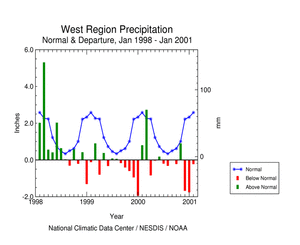 larger image |
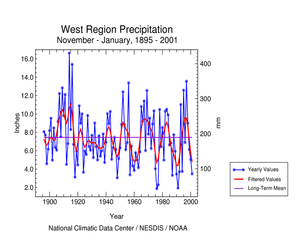 arger image |
 Northeast U.S. Dryness
Northeast U.S. Dryness
| Widespread dryness occurred across the Northeast region during January 2001, with the month ranking as the eighth driest January on record. Three of the last four months have had below normal precipitation (see graph to right), but near normal precipitation in December and wet conditions during the first half of 2000 have kept the long-term conditions in balance, with February 2000-January 2001 ranking as the 35th wettest (72nd driest) such 12-month period on record. | 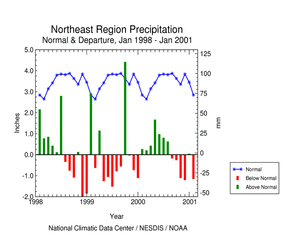 larger image |
 Southwest U.S. Conditions
Southwest U.S. Conditions
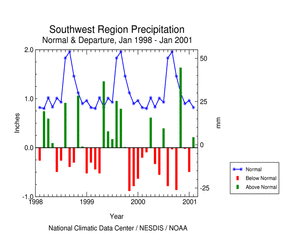 larger image |
Precipitation departures in the U.S. Southwest have varied considerably during the past several months, both over space and time (see graph to left). In Arizona, for example, unusually dry conditions during July, September, and December 2000 were balanced by extremely wet conditions during October to result in a statewide rank of 53rd driest out of 106 for February 2000-January 2001, 75th driest (32nd wettest) for August 2000-January 2001, and 40th driest for November 2000-January 2001. |
 Hawaiian Drought
Hawaiian Drought
| The Hawaiian Islands have experienced very dry conditions in recent months (see graph to right for Honolulu). All reporting stations had below normal precipitation during January 2001, with three-fourths of them (52 stations) reporting less than 20% of normal for the month. This followed a dry December when most stations reported below normal rainfall. Honolulu had the driest December-January on record in 2000-01 (see graph below left) and the fourth driest February-January (see graph below right). As noted by the National Weather Service office in Honolulu, "the lack of December 2000 and January 2001 rainfall showed that Hawaii was well on its way toward a fourth consecutive cool season with sub-par totals." | 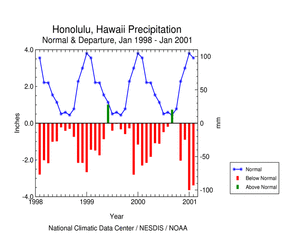 larger image |
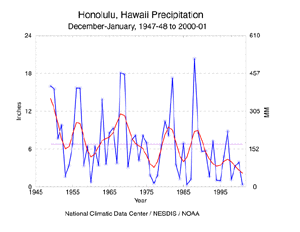 larger image |
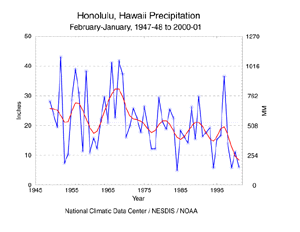 larger image |

 Additional Contacts:
Additional Contacts:
| Damage due to the drought has been summarized by NOAA and the Office of Global Programs in the Climatological Impacts section of the Climate Information Project. Crop impact information can be found at the USDA NASS (National Agricultural Statistics Service) and Weekly Weather and Crop Bulletin pages. Drought statements by local National Weather Service Offices can be found at the NWS Hydrologic Information Center. Drought threat assessments and other information can be found at NOAA's Drought Information Center. Additional drought information can be found at the National Drought Mitigation Center, the USDA's National Agricultural Library, and the NOAA Paleoclimatology Program. The following states have set up web pages detailing their drought emergencies:
New Mexico - North Carolina - Oklahoma - South Carolina - Texas For additional information on the 2000 wildfire season please see the National Interagency Fire Center web site or the U.S. Forest Service Fire and Aviation web site. Additional climate monitoring graphics can be found at the Climate Prediction Center's monitoring pages: |
 NOAA's National Centers for Environmental Information
NOAA's National Centers for Environmental Information
